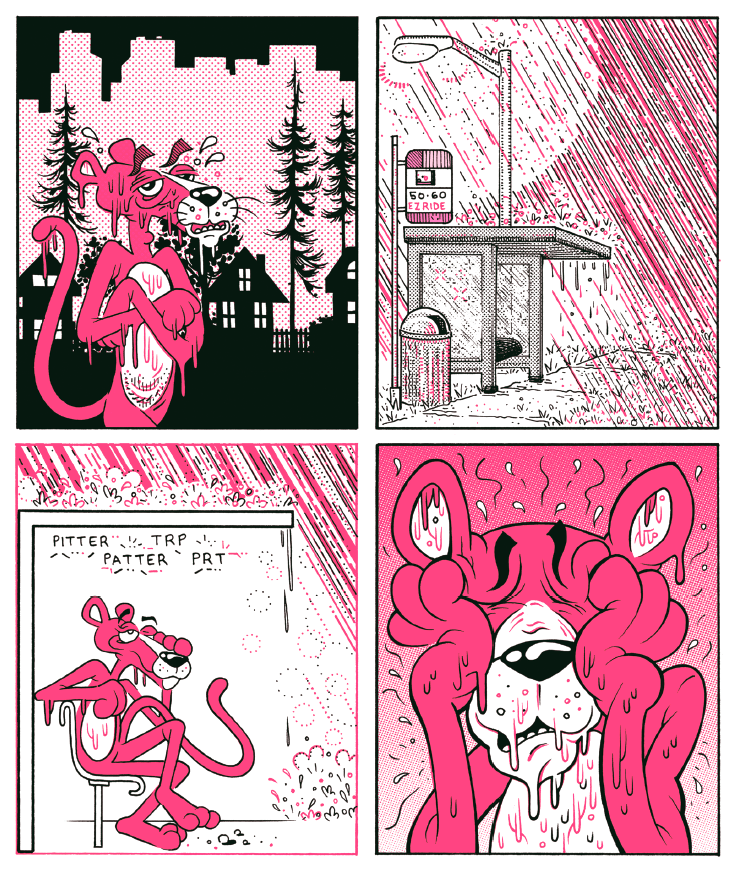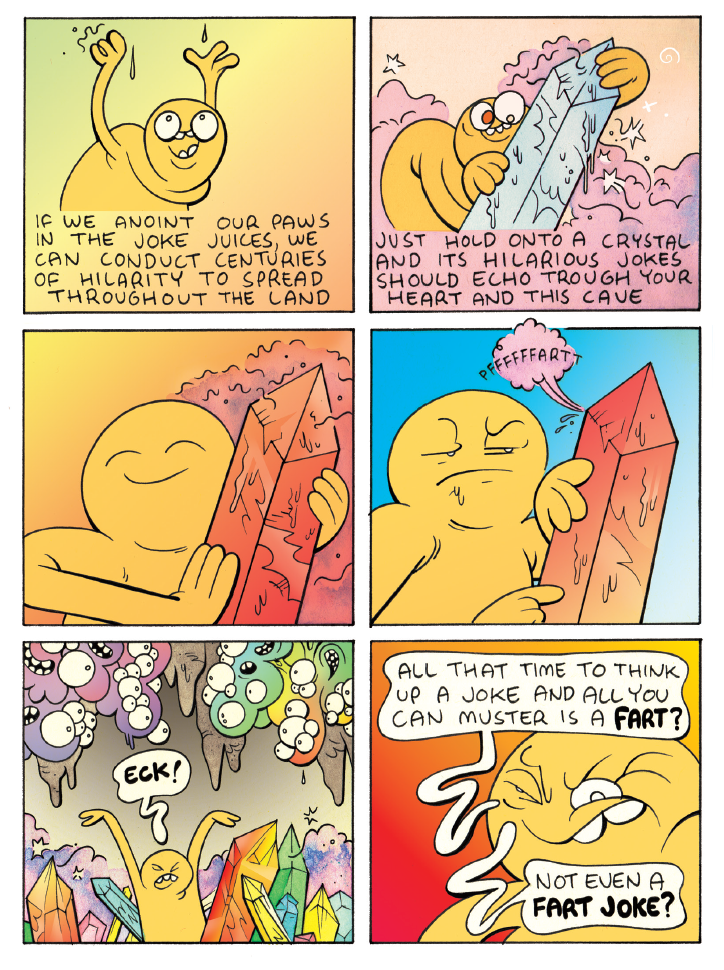The dense, adroit and textural cartooning of James Stanton, who often signs his work “James the Stanton”, has been a highlight of modern comics over the past decade. Stanton’s voice as artist, colorist and humorist is distinct: friendly, unassuming and deadpan as the visual and verbal curlicues of his work delight and astound the reader.
Stanton’s work was a highlight of the soon-to-be-legendary Seattle tabloid comix publication Intruder, which was still in its heyday when I moved away from the Emerald City in 2014. Like Tom Van Deusen and Max Clotfelter, Stanton created (and creates) playful, tactile comics and pages. Stanton may be comics’ king doodler of our times. He fills his pages with interlocking, overlapping images, text and decorations that suggest a 1970s underground comix approach to Cubism. There’s nothing retro about his work; its focus is on the roads less traveled—of deep woods shrouded in fog, fungi and moss, moist, oozing and far-removed from the grime and racket of city life.

Gnartoons the book is a compendium of Stanton’s work going back to 2010. Sketchbook pages, band posters and one-page stories alternate with longer pieces that weave a woozy path of stream-of-consciousness humor laced with occasional social commentary and plenty of goo and drippin’s. For all its daunting detail and sometimes-dark imagery, Stanton’s comics are genial and leisurely. In them, things just happen; one curious incident flows into another. Like the Russian novelist Nikolai Gogol, Stanton presents the dreamlike, improbable and what-the-hell-ial as though it’s the most natural thing in the world.
Stories like “Limo King”, “Melancholic Monster Brunch” and “Morsel” depict a palpable world of constant change taken for granted, as in a dream. Funny and sad moments flow with a matter-of-factness that makes them viable. It’s easy to be absorbed in Stanton’s skilled drawings, with their buoyant linework and dayglo color palettes; the reader in a more meditative mindset might spend 10, 20 minutes wandering their eyes from corner to corner on many pages. There is substance in concert with this hardcore eye-candy, and moments from these pieces may be recalled while in some public place where, after bursting out in laughter, you’ve startled other people who could never understand the source of your amusement; it would take too long to explain.

Stanton has a natural sense of design. Late in the book, in a selection of sketchbook pages, are a couple of spreads where the stickers attached to fruit and other produce are artfully arrayed, with doodles in the gaps between the labels. The UPC barcodes become vivid design elements on these pages, and I’ve probably blown a half-hour of my life getting lost in this mishmash of discarded commerce.
His attention to little things—to the parts of life that most adults are trained to ignore—makes Stanton’s work a joy of 21st-century cartooning. He appropriates pieces of pop culture, as in the story “Puke Banter”, in which a miserable, ailing Pink Panther suffers in the Northwestern rain and makes a biohazard zone at a bus stop. This morphs into a poetic muse on the nature of puke and how the world takes care of it, given enough time.

Like Chris Cilla, Stanton has a gift for realizing dream logic and the compression and anxiety of the subconscious. In an untitled story late in the book, the narrator learns that his pants have turned into monsters. He must cope with this unwelcome change, as he anticipates a gorge on Christmas cookies at a holiday party. As in a dream, events conflate and peter out in unseen ways; it’s a delight to see this stream-of-subconsciousness put on paper with such resonance.
Those content with eyeball kicks will find millions lodged in this handsome hardcover’s innards. Come for the art, stay for the stories. From the backwoods madness of “Limo King” to the mini-masterpiece “Morsel”, which imagines humor as a mineral found in nature, to “Merlin, Classroom Guinea Pig” (with a punchline worthy of Roald Dahl), the narrative content of Stanton’s work is as strong as his masterful linework and dense visual conceptions.

Were I asked to choose a favorite story, if might be 2018’s “Breakfast Socks”. Here, Stanton’s elegant, dense cartooning intersects with his playful, poker-faced wit to sublime effect. Or it could be the “Squatters of Trash Island” stories, which are as dystopian as Stanton’s work gets.
Comics need to remain pliable, playful and off-kilter. It does my heart good to see this spirit so strong and delightful in Stanton’s work. I hope we’ll see another handsome, wild volume of Gnartoons in the not-too-distant future.







